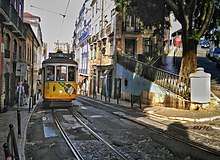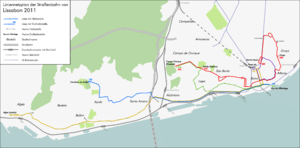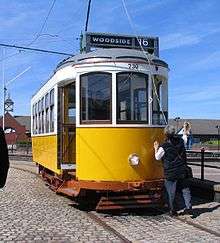Trams in Lisbon
The Lisbon tramway network (Portuguese: Rede de elétricos de Lisboa) is a system of trams that serve Lisbon, capital city of Portugal. In operation since 1873, it presently comprises six lines. The system has a length of 31km, and 63 trams in operation (45 historic "Remodelados", 8 historic "Ligeiros" and 10 modern articulated trams). The depot is located in Santo Amaro, in Alcântara.
| Lisbon tramway network | |||||||||||||||||||||
|---|---|---|---|---|---|---|---|---|---|---|---|---|---|---|---|---|---|---|---|---|---|
.jpg) A Lisbon Tram stopped at Praça do Comércio | |||||||||||||||||||||
| Operation | |||||||||||||||||||||
| Locale | Lisbon, Portugal | ||||||||||||||||||||
| |||||||||||||||||||||
| |||||||||||||||||||||
History

The first tramway in Lisbon entered service on 17 November 1873, as a horsecar line. On 30 August 1901, Lisbon's first electric tramway commenced operations. Within a year, all of the city's tramways had been converted to electric traction.
Until 1959, the network of lines continued to be developed, and in that year it reached its greatest extent. At that time, there were 27 tram lines in Lisbon, of which six operated as circle lines. As the circle lines operated in both clockwise and anticlockwise directions, each with its own route number, it is more correct to speak of a total of 24 tram routes, all of them running on 900 mm (2 ft 11 7⁄16 in) narrow gauge tram lines.
The slow decline of the network began with the construction of the Lisbon Metro and the expansion of the bus system.
Current network

The current lines are:
- 12 - Praça da Figueira → Miradouro de Santa Luzia circular route (clockwise only)
- 15 - Praça da Figueira ↔ Belém ↔ Algés
- 18 - Cais do Sodré railway station ↔ Cemitério da Ajuda
- 24 - Praça Luís de Camões ↔ Campolide
- 25 - Rua Alfândega ↔ Campo de Ourique (Prazeres)
- 28 - Praça Martim Moniz ↔ Graça ↔ Estrela ↔ Campo de Ourique (Prazeres)
The six remaining lines operate in the southern centre and west of the city only. Aside from the obvious tourist attraction, those lines are still very important because sections of the city's topography can only be crossed by small trams. Tram 15 also connects the entire western riverfront of the city to the centre and allows a better link for passengers with the bus system towards an area that still is not served by the metro.
Although reports prepared by both the École Polytechnique Fédérale de Lausanne and the Verkehrsbetriebe Zürich concluded that the network should be retained and even extended, the process of decline continued until 1997, with the closing of the Alto de São João branch and the Arco Cego depot. By that time, many trams were destroyed or sold to other companies. In the following twenty years, there was only one change to the system, with the shortening of Line 18 to Cais do Sodré.
Expansion
In an apparent reversal of policy, the mayor (president of the city council) of Lisbon, Fernando Medina, announced in December 2016 that tram 24 would be restored to service in 2017 between Cais do Sodré and Campolide, saying that it was a mistake to reduce the city's network of electric trams and that work would be undertaken to reconstruct it.[3]
Carris originally said this was not a priority, but its 2018 Activity and Budget Plan[4] provides for the purchase in 2020-2021 of:
- 10 more remodelados to augment the current historical fleet and reopen line 24 between Cais do Sodré and Campolide, at a cost of €8 million;
- 20 more articulated trams to extend line 15 eastwards to Santa Apolónia station and the Parque de Nações, at a cost of €50 million.
On 24 April 2018, Line 24 was reopened, albeit initially between Camões and Campolide only. Track connections to the rebuilt loop at Cais do Sodré and some other track issues between Camões and Cais do Sodré will need to be attended to before operation to Cais do Sodré is possible.[5][6]
Rolling stock
The tram fleet has fallen in size from 57 in 2012 to 48 in 2016.[4] Vehicles used are:
- 'Articulado' trams made by Siemens (Siemens/CAF nos 501-506 and Siemens/Sorefame nos 507-510). These articulated vehicles were introduced in 1995, and run only on route 15.
- 'Remodelado' trams (nos 541-585) used on all routes.
- Tourist trams used on some routes.
References
Notes
- Luso pages, Lisbon Trams, Part Two: Trams of The Past.
- Luso pages, Lisbon Trams, Part One: Trams of Today.
- Cardoso, Margarida David. (2016-12-15) "Eléctrico 24 vai estar de volta às ruas de Lisboa e as obras já começaram." https://www.publico.pt/2016/12/15/local/noticia/electrico-24-vai-estar-de-volta-as-ruas-de-lisboa-e-as-obras-ja-comecaram-1754996. Retrieved 2016-12-18 (in Portuguese).
- http://www.carris.pt/fotos/editor2/pao_carris_2018_site.pdf
- Faria Moreira, Cristiana (24 April 2018). "Pedido pelos lisboetas, o 24 voltou e logo se encheu de turistas" [On request by the Lisboans, the 24 returned and it was soon filled with tourists]. Público (in Portuguese). Sonae SGPS, S.A. Retrieved 2018-04-28.
- Lisboa tram route reinstated after 23 years Metro Report International 27 April 2018
Books
- King, B R; Price, J H (1995). The Tramways of Portugal (4th ed.). London: Light Rail Transit Association. ISBN 0-948106-19-0.
- Tavares Dias, Marina (2001). História do eléctrico da Carris: The history of the Lisbon trams. Lisboa: Quimera. ISBN 972-589-066-3. (in Portuguese and English)
Website
- Laidlar, John. "Lisbon Trams, Part One: Trams of Today". The Luso Pages. Laidlar, John. Retrieved 10 March 2011.
- Laidlar, John. "Lisbon Trams, Part Two: Trams of The Past". The Luso Pages. Laidlar, John. Retrieved 10 March 2011.
External links
| Wikimedia Commons has media related to Trams in Lisbon. |
This article is based upon a translation of the German language version as at March 2011.


